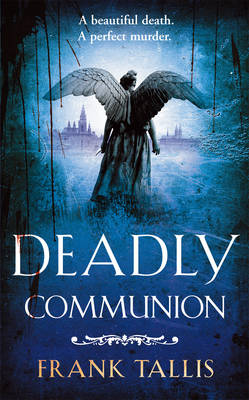
EURO CRIME
Reviews

Tallis, Frank - 'Deadly Communion'
Paperback: (Jan. 2010) Publisher: Century ISBN: 1846053595
DEADLY COMMUNION, is the fifth in the Liebermann series, by the Harley Street psychologist Frank Tallis, and is set in Vienna at the turn of the 19th century. Towards the start of the book, a body of a young girl is found, murdered by the insertion of a hat pin into her brain. The pathologist detects that she had 'received a man' by smell (an interesting autopsy technique), but she appears to have consented, so why did he kill her? Detective Inspector Reinhardt enlists a psychologist, Dr Liebermann to help him with his case, and after some discussion Liebermann suggests that the killer is a thanatophiliac, someone who finds death arousing. Reinhardt dispatches his assistant to find the supplier of the hatpin, and the first description of the possible murderer. Meanwhile, Dr Liebermann is treating a male patient (Reinmayr) who is convinced he has seen his doppleganger and is about to die. Then a second victim is found, again stabbed with a hatpin, and then a third, this time stabbed with a dagger. A few chapters interspersed with the main story, apparently written by the murderer, gradually describe his early life, and start to give some insight into his motivation for the murders. Gradually, Reinhardt, helped by Liebermann, discovers the identity of the murderer and they manage to apprehend him. But just when it appears that all is solved, there are still a few twists in the story to come.
This is a gently written novel, helped by the period setting, which means that there are limited resources available for detection of the murderer, other than simple old fashioned detective work, a bit of luck, and in this case the use of psychology to try to determine the motivation for the crimes. The descriptions of the post-mortems are intriguing, particularly when Miss Lydgate, a friend of Liebermann's, joins the pathologist to help out. She instinctively knows the right order in which to arrange the dissection tools, and she is able to offer practical help with suggestions for finding out the blood type of a sample of blood under the fingernails of the second victim. [As I sometimes have to teach histology to undergraduates, I particularly liked the description of her use of hemotoxylin (which would have been available at the time) to stain a vaginal sample from the third victim to look for sperm cells under the microscope.] Dr Liebermann uses his knowledge of psychology well, not only to understand the motivations behind the main murderer in the book, but also to treat Rainmayr, and discover what is behind his apparent madness. Liebermann even has some interesting and useful discussions with Freud himself at a couple of points in the book.
The real strength of the book is the psychological insight that Liebermann has into the possible motivation behind the various crimes, coupled with the intriguing character of Reinhardt, his taste for pastries and biscuits, and his ability to instinctively sense when witnesses tell him something important that he should follow up. The book has a similar feel to books by Andrew Taylor, but I really enjoyed the more psychological angle used here. If I had one little nag, it would be that the book would have benefited from a little bit more 'signposting' here and there, which would have made the book a little more engrossing, and drawn the reader in more deeply. But this is an interesting, intelligent and enjoyable read, and has sufficient depth to it that it is one I'd be happy to keep on the bookshelves to read again.
Michelle Peckham, England
January 2010
Details of the author's other books with links to reviews can be found on the Books page.
More European crime fiction reviews can be found on the Reviews page.